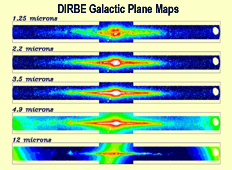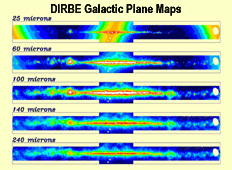|
Introduction
DIRBE (Diffuse Infrared Background Experiment)
DMR (Differential Microwave Radiometers)
FIRAS (Far Infrared Absolute Spectrophotometer)
More Information about COBE
COBE Explained
History of COBE project
Structure in the COBE differential microwave radiometer first-year maps. Smoot, et al. 1992. Initial publication showing COBE results. PDF file
COBE DMR 2 & 4-Year Images
WMAP (Wilkinson Microwave Anisotropy Probe) CMB satellite 5 year data papers
Introduction
NASA's COBE (Cosmic Background Explorer) satellite was developed to measure the diffuse infrared and cosmic microwave background radiation from the early Universe to the limits set by our astrophysical environment. COBE was launched on November 18, 1989 and carried three instruments: DIRBE (the Diffuse InfraRed Experiment) to search for and measure the cosmic infrared background radiation, DMR (Differential Microwave Radiometers) to map the cosmic microwave background radiation precisely, and FIRAS (Far-InfraRed Absolute Spectrophotometer) to compare the spectrum of the cosmic microwave background radiation with that from a precise blackbody.
Data from the full four years of COBE observations continue to be analyzed. Student and postdoctoral opportunities exist.
A large number of people were involved at various stages in the COBE project.
DIRBE (Diffuse Infrared Background Experiment)
DIRBE has mapped the absolute sky brightness in 10 wavelength bands ranging from 1.25 microns to 240 microns. These data contain the signal from the cosmic infrared background and the foreground emissions from extragalactic sources, our Galaxy, and dust and other sources in our solar system. Work is in progress on separating and modeling the various components. Significantly improved limits on the cosmic infrared background exist and future progress is possible and likely. A significant amount of work involves study of the astrophysics of the interesting foreground sources. There is a very rich data base on the infrared emission from the Galaxy and the interplanetary dust.
Galactic plane emission: bands 1-5

Galactic plane emission: bands 6-10

DMR (Differential Microwave Radiometers)
The COBE DMR (Smoot et al. 1992) has found anisotropies in the cosmic microwave background on all scales from the nominal beam size of 7-degrees up to the full sky at a typical level of one part in 100,000 to a few parts per million. These anisotropies are interpreted as imprints of the seeds that eventually grew under the influence of gravity to galaxies, clusters of galaxies, and clusters of clusters of galaxies. They also indicate that we should eventually expect to find even larger scale structures. They also give us a clue to how the universe originated - i.e. how space and time and all the other contents of the universe came into being. Data processing of all four years was released in January 1996. The DMR team had a large number of members over the years in addition to those from the COBE science working group that participated.
DMR Schematic

CMB Fluctuations (2 years of data)

CMB Fluctuations (galaxy removed)

DMR Four Year images of the Cosmic Microwave Background Fluctuations.
FIRAS (Far Infrared Absolute Spectrophotometer)
FIRAS has shown that the cosmic microwave background spectrum matches that of a blackbody of temperature 2.726K with a precision of 0.03% of the peak intensity over a wavelength range 0.1 to 5 mm. Longer wavelength measurements, though not nearly as precise, conducted by Smoot's group at Lawrence Berkeley Lab and collaborators and by other groups, show that the CMB spectrum is elucidated by a single temperature blackbody. See figure of spectrum measurements below. These measurements strongly limit possible alternative models to the Big Bang and limit potential energy releases in the early Universe, typically to less than 0.1% to 0.01%.
CMB Intensity plot
CMB Temperature plot
Energy Release Limits plot
FIRAS Instrument Block Diagram
Example of Blackbody Curves

More Information
Extensive information about the COBE mission, including much information about the three experiments on board, is available by clicking on the COBE archives or through NASA. More photographs related to COBE. NASA was responsible for the development of the COBE satellite and mission operations. Scientific Guidance was provided by the COBE Science Working Group.
COBE display for LBNL 75th Anniversary Symposium
Back to top
|







